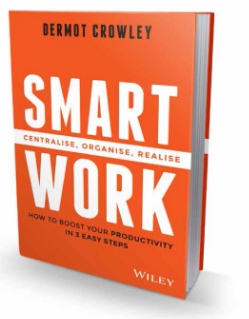How to Measure Productivity by Proxy
by Stacey Barr |Every organisation wants a productive workforce. But measuring productivity, which is critical to improving it, is a struggle. It’s hard to make it tangible. In his book Smart Work, productivity expert Dermot Crowley gives us a clue about how to measure productivity using a very practical proxy.

Productivity is a weasel word. That means it has different meanings to different people in different contexts and different places. You can’t measure something until you decide its one meaning.
And you can’t measure something until you can describe it in observable language. To describe productivity in observable language would be to list the bazillion things that everyone does in an organisation, and describe what it looks like when each of those things are done productively.
Measuring all those things, to quantify productivity, is too overwhelming. It means collecting data on just about everything people do. The effort feels too high, compared to the benefit of measuring productivity. And doing all that measuring would, itself, probably make productivity worse! But this isn’t the only way to approach the problem of how to measure productivity.
Dermot Crowley explains that “inbox zero” – clearing our email inbox at least weekly – is a keystone habit of productivity. When we master a keystone habit, all other related habits become a breeze to practice.
So, if we want a productive workforce, then the more that people master the habit of getting their email inbox to zero at least weekly, the more that other productive habits flourish, such as:
- meetings are less frequent and take less time
- projects and their milestones are completed on time and with less effort
- work tasks are performed with less rework
- outputs are produced with less effort to produce them
- promises are delivered with less effort to deliver them
This suggests that a powerful proxy measure of productivity could be the percentage of people that reach the state of “inbox zero” at least once each week. It’s easy to collect the data, and can be automated in many organisations. It’s generally applicable to most people, irrespective of their job type. It can be monitored fairly frequently to pick up trends more quickly. And it’s simple to understand. It’s got a lot going for it.
And it does, like any measure that can be disaggregated down to individual people, have a dark side. And that’s the risk of driving the wrong behaviours. If people believe they will be monitored and “performance managed” by the volume of their inbox, there’s a good chance they will game the measure, or game the system by:
- deleting emails that really need to be responded to
- responding inadequately to emails to process them faster
- moving unprocessed emails into subfolders to “hide” them from inbox monitoring
- giving too high a priority to processing emails, and not getting their core work done
The solution to this is to NOT use this measure to monitor individual productivity. Only use the Inbox Zero measure at a corporate level, as a measure of the corporate productivity culture. Then, to improve productivity, attention shouldn’t drill down to team or individual performance in email management. It should drill down to the design of the organisation’s productivity approaches, and to the constraints that limit their proper execution.
And so, one practical and useful way to measure a productivity culture for an organisation is this proxy measure of “inbox zero”:
Inbox Zero: The percentage of email inboxes that reach a state of zero emails at least once each week, for the whole organisation.
Dermot Crowley’s book, Smart Work, is available at all good physical and online bookstores.
DISCUSSION:
How does your organisation measure productivity?
Connect with Stacey
Haven’t found what you’re looking for? Want more information? Fill out the form below and I’ll get in touch with you as soon as possible.
167 Eagle Street,
Brisbane Qld 4000,
Australia
ACN: 129953635
Director: Stacey Barr





